Deck 27: Exploring Relationships Among Variables
Question
Question
Question
Question
Question
Question
Question
Question
Question
Question
Question
Question
Question
Question
Question
Question
Question
Question
Question
Question
Question
Question
Question
Question
Question
Question
Question
Question
Question
Question
Question
Question
Question
Question
Question
Question
Question
Question
Question
Question

Unlock Deck
Sign up to unlock the cards in this deck!
Unlock Deck
Unlock Deck
1/40
Play
Full screen (f)
Deck 27: Exploring Relationships Among Variables
1
Which of the following is the correct interpretation for the regression coefficient of Gender?
A) The regression coefficient indicates that the job performance score for a female will, on average, be 9.06 points higher than for males of the same age and GPA.
B) The regression coefficient indicates that the job performance score for a female will, on average, be 9.06 points lower than for males of the same age and GPA.
C) The regression coefficient indicates that the job performance score for a female will, on average, be 9.06 times higher than for males.
D) The regression coefficient indicates that the job performance score for a female will, on average, be 9.06 times lower than for males.
E) The regression coefficient is not significantly different from zero.
A) The regression coefficient indicates that the job performance score for a female will, on average, be 9.06 points higher than for males of the same age and GPA.
B) The regression coefficient indicates that the job performance score for a female will, on average, be 9.06 points lower than for males of the same age and GPA.
C) The regression coefficient indicates that the job performance score for a female will, on average, be 9.06 times higher than for males.
D) The regression coefficient indicates that the job performance score for a female will, on average, be 9.06 times lower than for males.
E) The regression coefficient is not significantly different from zero.
A
2
The residual plot for a linear regression model is shown below. 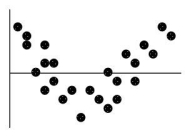 Which of the following is true?
Which of the following is true?
A) The linear model is okay because the same number of points is above the line as below it.
B) The linear model is okay because the association between the two variables is fairly strong.
C) The linear model is no good because the correlation is near 0.
D) The linear model is no good because some residuals are large.
E) The linear model is no good because of the curve in the residuals.
 Which of the following is true?
Which of the following is true?A) The linear model is okay because the same number of points is above the line as below it.
B) The linear model is okay because the association between the two variables is fairly strong.
C) The linear model is no good because the correlation is near 0.
D) The linear model is no good because some residuals are large.
E) The linear model is no good because of the curve in the residuals.
E
3
The model  = 12 + 20dia can be used to predict the breaking strength of a rope (in kilograms) from its diameter (in centimetres). According to this model, how much force should a rope one-half centimetre in diameter withstand?
= 12 + 20dia can be used to predict the breaking strength of a rope (in kilograms) from its diameter (in centimetres). According to this model, how much force should a rope one-half centimetre in diameter withstand?
A) 484 kilos
B) 16 kilos
C) 22 kilos
D) 256 kilos
E) 4.7 kilos
 = 12 + 20dia can be used to predict the breaking strength of a rope (in kilograms) from its diameter (in centimetres). According to this model, how much force should a rope one-half centimetre in diameter withstand?
= 12 + 20dia can be used to predict the breaking strength of a rope (in kilograms) from its diameter (in centimetres). According to this model, how much force should a rope one-half centimetre in diameter withstand?A) 484 kilos
B) 16 kilos
C) 22 kilos
D) 256 kilos
E) 4.7 kilos
A
4
Which of the following is not true about the best regression models?
A) They have relatively many predictors.
B) They have a relatively high R2 value.
C) They have predictors that are reliably measured and relatively unrelated to each other.
D) They have no cases with extraordinarily high leverage that might dominate and alter the model.
E) They have relatively small P-values for the F- and t-statistics.
A) They have relatively many predictors.
B) They have a relatively high R2 value.
C) They have predictors that are reliably measured and relatively unrelated to each other.
D) They have no cases with extraordinarily high leverage that might dominate and alter the model.
E) They have relatively small P-values for the F- and t-statistics.

Unlock Deck
Unlock for access to all 40 flashcards in this deck.
Unlock Deck
k this deck
5
Use the following to answer the question(s) below.
For many countries tourism is an important source of revenue. Data are collected on the number of foreign visitors to a country (in millions) and total tourism revenue (in billions of dollars) for a sample of 10 countries. Below is the regression analysis output with tourism revenue as the dependent variable.
The calculated t-statistic to test whether the regression slope is significantly different from zero is
A) 6.20
B) 13.88
C) 0.07917
D) 2.58307
E) 3.73
For many countries tourism is an important source of revenue. Data are collected on the number of foreign visitors to a country (in millions) and total tourism revenue (in billions of dollars) for a sample of 10 countries. Below is the regression analysis output with tourism revenue as the dependent variable.

The calculated t-statistic to test whether the regression slope is significantly different from zero is
A) 6.20
B) 13.88
C) 0.07917
D) 2.58307
E) 3.73

Unlock Deck
Unlock for access to all 40 flashcards in this deck.
Unlock Deck
k this deck
6
If we were interested in predicting the tourism revenue for a particular country that had 30 million foreign visitors
A) We should construct a confidence interval using this equation.
B) We should construct a predication interval using this equation.
C) We should not use this equation because it is not significant.
D) We should use the correlation.
E) We should use the standard error.
A) We should construct a confidence interval using this equation.
B) We should construct a predication interval using this equation.
C) We should not use this equation because it is not significant.
D) We should use the correlation.
E) We should use the standard error.

Unlock Deck
Unlock for access to all 40 flashcards in this deck.
Unlock Deck
k this deck
7
Use the following to answer the question(s) below.
A large pharmaceutical company selected a random sample of new hires and obtained their job performance ratings based on their first six months with the company. These data were used to build a multiple regression model to predict the job performance of new hires based on age, GPA and gender (female = 1 and male = 0). The results of the analysis are shown below.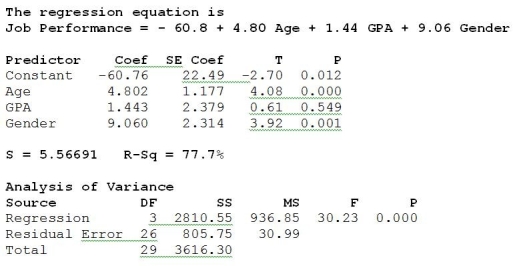
Based on the F-statistic and associated P-value, we can conclude that at α = 0.05
A) The regression equation is not significant.
B) All independent variables in the model are significant.
C) The regression model is significant overall.
D) None of the independent variables in the model are significant.
E) All independent variables in the model are significant and the regression equation is significant.
A large pharmaceutical company selected a random sample of new hires and obtained their job performance ratings based on their first six months with the company. These data were used to build a multiple regression model to predict the job performance of new hires based on age, GPA and gender (female = 1 and male = 0). The results of the analysis are shown below.

Based on the F-statistic and associated P-value, we can conclude that at α = 0.05
A) The regression equation is not significant.
B) All independent variables in the model are significant.
C) The regression model is significant overall.
D) None of the independent variables in the model are significant.
E) All independent variables in the model are significant and the regression equation is significant.

Unlock Deck
Unlock for access to all 40 flashcards in this deck.
Unlock Deck
k this deck
8
Use the following to answer the question(s) below.
Weekly commodity prices for heating oil (in cents) were obtained and regressed against time. Below is the regression output and residual plots from fitting a linear model.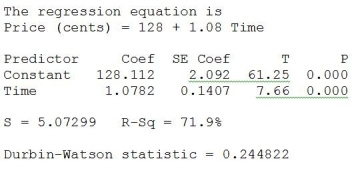
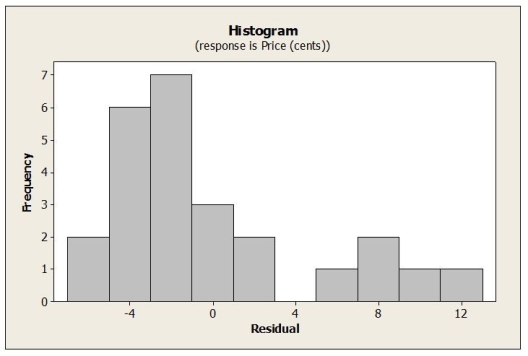
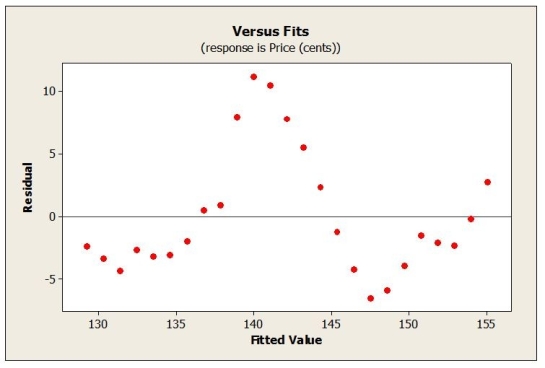
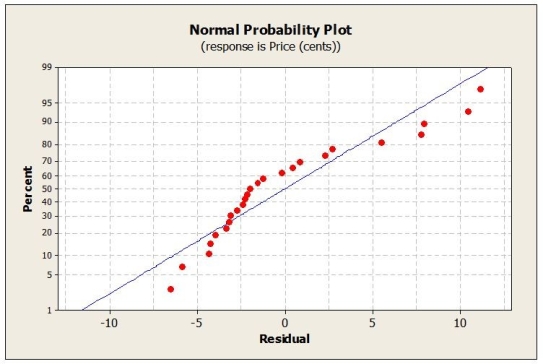
The Durbin-Watson statistic indicates
A) that the residuals are positively autocorrelated
B) that the residuals are negatively autocorrelated
C) that the residuals are not autocorrelated
D) that the test is inconclusive
E) The Durbin-Watson statistic cannot be used for this model.
Weekly commodity prices for heating oil (in cents) were obtained and regressed against time. Below is the regression output and residual plots from fitting a linear model.




The Durbin-Watson statistic indicates
A) that the residuals are positively autocorrelated
B) that the residuals are negatively autocorrelated
C) that the residuals are not autocorrelated
D) that the test is inconclusive
E) The Durbin-Watson statistic cannot be used for this model.

Unlock Deck
Unlock for access to all 40 flashcards in this deck.
Unlock Deck
k this deck
9
Use the following to answer the question(s) below.
In order to examine if there is a relationship between the size of cash bonuses and pay scale, data were obtained on the average annual cash bonus and the average annual pay for a sample of 20 companies. Below is the regression analysis output with annual cash bonus as the dependent variable.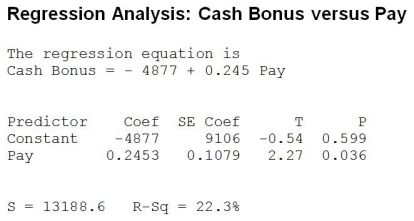
At 5% significance level, which of the following statements is true about the correlation between average annual cash bonus and average annual pay?
A) It is not significantly different from zero.
B) It is negative but not significantly different from zero.
C) It is positive and significantly different from zero.
D) It is negative and significantly different from zero.
E) Cannot be determined from the information given.
In order to examine if there is a relationship between the size of cash bonuses and pay scale, data were obtained on the average annual cash bonus and the average annual pay for a sample of 20 companies. Below is the regression analysis output with annual cash bonus as the dependent variable.

At 5% significance level, which of the following statements is true about the correlation between average annual cash bonus and average annual pay?
A) It is not significantly different from zero.
B) It is negative but not significantly different from zero.
C) It is positive and significantly different from zero.
D) It is negative and significantly different from zero.
E) Cannot be determined from the information given.

Unlock Deck
Unlock for access to all 40 flashcards in this deck.
Unlock Deck
k this deck
10
Below is the plot of residuals versus fitted values for this regression model.  Which assumption appears to be violated?
Which assumption appears to be violated?
A) Equal Variance
B) Linearity
C) Normality
D) Independence
E) None; all appear to be satisfied.
 Which assumption appears to be violated?
Which assumption appears to be violated?A) Equal Variance
B) Linearity
C) Normality
D) Independence
E) None; all appear to be satisfied.

Unlock Deck
Unlock for access to all 40 flashcards in this deck.
Unlock Deck
k this deck
11
At α = 0.05 we can conclude that
A) Age is not a significant variable in predicting job performance.
B) GPA is a significant variable in predicting job performance.
C) The regression coefficient associated with GPA is significantly different from zero.
D) Gender is a significant variable in predicting job performance.
E) The regression coefficient associated with Age is not significantly different from zero.
A) Age is not a significant variable in predicting job performance.
B) GPA is a significant variable in predicting job performance.
C) The regression coefficient associated with GPA is significantly different from zero.
D) Gender is a significant variable in predicting job performance.
E) The regression coefficient associated with Age is not significantly different from zero.

Unlock Deck
Unlock for access to all 40 flashcards in this deck.
Unlock Deck
k this deck
12
Use the following to answer the question(s) below.
Weekly commodity prices for heating oil (in cents) were obtained and regressed against time. Below is the regression output and residual plots from fitting a linear model.



Which assumption appears to be violated?
A) Linearity
B) Normality
C) Equal Variance
D) Linearity and Normality
E) Linearity, Normality and Equal Variance assumptions are violated.
Weekly commodity prices for heating oil (in cents) were obtained and regressed against time. Below is the regression output and residual plots from fitting a linear model.




Which assumption appears to be violated?
A) Linearity
B) Normality
C) Equal Variance
D) Linearity and Normality
E) Linearity, Normality and Equal Variance assumptions are violated.

Unlock Deck
Unlock for access to all 40 flashcards in this deck.
Unlock Deck
k this deck
13
Use the following to answer the question(s) below.
A large pharmaceutical company selected a random sample of new hires and obtained their job performance ratings based on their first six months with the company. These data were used to build a multiple regression model to predict the job performance of new hires based on age, GPA and gender (female = 1 and male = 0). The results of the analysis are shown below.
How much of the variability in Job Performance is explained by the regression model?
A) 30.33 %
B) 77.7 %
C) 5.56 %
D) 60.76 %
E) Cannot be determined.
A large pharmaceutical company selected a random sample of new hires and obtained their job performance ratings based on their first six months with the company. These data were used to build a multiple regression model to predict the job performance of new hires based on age, GPA and gender (female = 1 and male = 0). The results of the analysis are shown below.

How much of the variability in Job Performance is explained by the regression model?
A) 30.33 %
B) 77.7 %
C) 5.56 %
D) 60.76 %
E) Cannot be determined.

Unlock Deck
Unlock for access to all 40 flashcards in this deck.
Unlock Deck
k this deck
14
A forester would like to estimate the diameter of maple trees based on age. She gathers data from trees that have been cut and plots their diameters (in inches) against their ages (in years). She fits a linear model and both the scatterplot and residual plots are shown below. 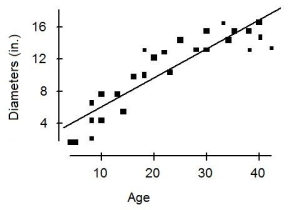
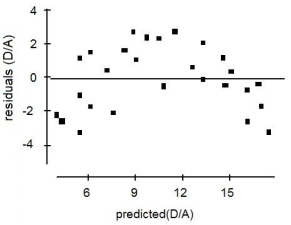 Which of the following is true?
Which of the following is true?
A) If we used this model to predict the diameter of a maple tree that is 50 years old, the predicted value would be too low.
B) If we used this model to predict the diameter of a maple tree that is 50 years old, the predicted value would be quite reliable.
C) Re-expressing these data by taking the logarithm of age would not improve this model.
D) If we used this model to predict the diameter of a maple tree that is 50 years old, the predicted value would be too low or it would be too high.
E) If we used this model to predict the diameter of a maple tree that is 50 years old, the predicted value would be too high, furthermore, re-expressing these data by taking the logarithm of age would improve this model.

 Which of the following is true?
Which of the following is true?A) If we used this model to predict the diameter of a maple tree that is 50 years old, the predicted value would be too low.
B) If we used this model to predict the diameter of a maple tree that is 50 years old, the predicted value would be quite reliable.
C) Re-expressing these data by taking the logarithm of age would not improve this model.
D) If we used this model to predict the diameter of a maple tree that is 50 years old, the predicted value would be too low or it would be too high.
E) If we used this model to predict the diameter of a maple tree that is 50 years old, the predicted value would be too high, furthermore, re-expressing these data by taking the logarithm of age would improve this model.

Unlock Deck
Unlock for access to all 40 flashcards in this deck.
Unlock Deck
k this deck
15
At the 0.05 level of significance
A) We reject the null hypothesis.
B) We do not reject the null hypothesis.
C) We conclude that the number of foreign visitors is significant in explaining tourism revenue.
D) We reject the null hypothesis, and we conclude that the number of foreign visitors is significant in explaining tourism revenue.
E) We do not reject the null hypothesis and we conclude that the number of foreign visitors is significant in explaining tourism revenue.
A) We reject the null hypothesis.
B) We do not reject the null hypothesis.
C) We conclude that the number of foreign visitors is significant in explaining tourism revenue.
D) We reject the null hypothesis, and we conclude that the number of foreign visitors is significant in explaining tourism revenue.
E) We do not reject the null hypothesis and we conclude that the number of foreign visitors is significant in explaining tourism revenue.

Unlock Deck
Unlock for access to all 40 flashcards in this deck.
Unlock Deck
k this deck
16
Use the following to answer the question(s) below.
Weekly commodity prices for heating oil (in cents) were obtained and regressed against time. Below is the regression output and residual plots from fitting a linear model.



Which of the following statements is true?
A) The t-test for the regression slope indicates that it is significantly different from zero.
B) The model explains 71.9% of the variability in heating oil prices.
C) The linear model is appropriate.
D) The t-test for the regression slope indicates that it is significantly different from zero and the model explains 71.9% of the variability in heating oil prices.
E) All of the statements given are true.
Weekly commodity prices for heating oil (in cents) were obtained and regressed against time. Below is the regression output and residual plots from fitting a linear model.




Which of the following statements is true?
A) The t-test for the regression slope indicates that it is significantly different from zero.
B) The model explains 71.9% of the variability in heating oil prices.
C) The linear model is appropriate.
D) The t-test for the regression slope indicates that it is significantly different from zero and the model explains 71.9% of the variability in heating oil prices.
E) All of the statements given are true.

Unlock Deck
Unlock for access to all 40 flashcards in this deck.
Unlock Deck
k this deck
17
Use the following to answer the question(s) below.
For many countries tourism is an important source of revenue. Data are collected on the number of foreign visitors to a country (in millions) and total tourism revenue (in billions of dollars) for a sample of 10 countries. Below is the regression analysis output with tourism revenue as the dependent variable.
The standard error of the slope for this estimated regression equation is
A) 2.58307
B) 3.462
C) 0.07917
D) 6.672
E) 0.29497
For many countries tourism is an important source of revenue. Data are collected on the number of foreign visitors to a country (in millions) and total tourism revenue (in billions of dollars) for a sample of 10 countries. Below is the regression analysis output with tourism revenue as the dependent variable.

The standard error of the slope for this estimated regression equation is
A) 2.58307
B) 3.462
C) 0.07917
D) 6.672
E) 0.29497

Unlock Deck
Unlock for access to all 40 flashcards in this deck.
Unlock Deck
k this deck
18
Use the following to answer the question(s) below.
In order to examine if there is a relationship between the size of cash bonuses and pay scale, data were obtained on the average annual cash bonus and the average annual pay for a sample of 20 companies. Below is the regression analysis output with annual cash bonus as the dependent variable.
What is the correlation between average annual cash bonus and average annual pay?
A) -0.223
B) 0.472
C) 0.108
D) -0.540
E) Cannot be determined from the information given.
In order to examine if there is a relationship between the size of cash bonuses and pay scale, data were obtained on the average annual cash bonus and the average annual pay for a sample of 20 companies. Below is the regression analysis output with annual cash bonus as the dependent variable.

What is the correlation between average annual cash bonus and average annual pay?
A) -0.223
B) 0.472
C) 0.108
D) -0.540
E) Cannot be determined from the information given.

Unlock Deck
Unlock for access to all 40 flashcards in this deck.
Unlock Deck
k this deck
19
How much of the variability in tourism revenue is accounted for by the number of foreign visitors?
A) 63.4 %
B) 13.8 %
C) 2.58 billion $
D) 21.464 %
E) 3.73 billion $
A) 63.4 %
B) 13.8 %
C) 2.58 billion $
D) 21.464 %
E) 3.73 billion $

Unlock Deck
Unlock for access to all 40 flashcards in this deck.
Unlock Deck
k this deck
20
Which statement about residuals plot is true?
I) A curved pattern indicates nonlinear association between the variables.
II) A pattern of increasing spread indicates the predicted values become less reliable as the explanatory variable increases.
III) If all of the residuals are very small, the model will predict accurately.
A) I only
B) II only
C) I and II
D) I and III
E) I, II and III
I) A curved pattern indicates nonlinear association between the variables.
II) A pattern of increasing spread indicates the predicted values become less reliable as the explanatory variable increases.
III) If all of the residuals are very small, the model will predict accurately.
A) I only
B) II only
C) I and II
D) I and III
E) I, II and III

Unlock Deck
Unlock for access to all 40 flashcards in this deck.
Unlock Deck
k this deck
21
The model  = 3.30 + 0.235 × speed can be used to predict the stopping distance (in metres) for a car traveling at a specific speed (in kph). According to this model, about how much distance will a car going 65 kph need to stop?
= 3.30 + 0.235 × speed can be used to predict the stopping distance (in metres) for a car traveling at a specific speed (in kph). According to this model, about how much distance will a car going 65 kph need to stop?
A) 345.0 metres
B) 18.6 metres
C) 27.0 metres
D) 4.3 metres
E) 729.0 metres
 = 3.30 + 0.235 × speed can be used to predict the stopping distance (in metres) for a car traveling at a specific speed (in kph). According to this model, about how much distance will a car going 65 kph need to stop?
= 3.30 + 0.235 × speed can be used to predict the stopping distance (in metres) for a car traveling at a specific speed (in kph). According to this model, about how much distance will a car going 65 kph need to stop?A) 345.0 metres
B) 18.6 metres
C) 27.0 metres
D) 4.3 metres
E) 729.0 metres

Unlock Deck
Unlock for access to all 40 flashcards in this deck.
Unlock Deck
k this deck
22
Use the following to answer the question(s) below.
A linear regression model was fit to data representing technology adoption over time. The regression output and residual plot appears below.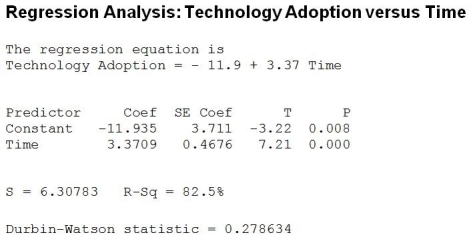
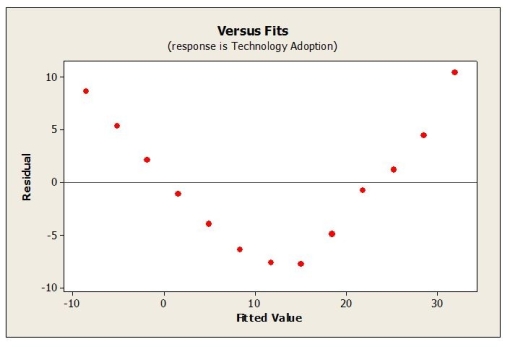
Which of the following is true?
A) The linear model explains 82.5 % of the variability in technology adoption.
B) The linear model is appropriate.
C) The linear model is not appropriate.
D) The linear model explains 82.5 % of the variability in technology adoption and the linear model is appropriate.
E) The linear model explains 82.5 % of the variability in technology adoption and the linear model is not appropriate.
A linear regression model was fit to data representing technology adoption over time. The regression output and residual plot appears below.


Which of the following is true?
A) The linear model explains 82.5 % of the variability in technology adoption.
B) The linear model is appropriate.
C) The linear model is not appropriate.
D) The linear model explains 82.5 % of the variability in technology adoption and the linear model is appropriate.
E) The linear model explains 82.5 % of the variability in technology adoption and the linear model is not appropriate.

Unlock Deck
Unlock for access to all 40 flashcards in this deck.
Unlock Deck
k this deck
23
Which statement about re-expressing data is true?
I) Unimodal distributions that are skewed to the left can be made more symmetric by taking the square root of the variable.
II) A curve that is descending as the explanatory variable increases may be straightened by taking a logarithm of the response variable.
III) One goal of re-expression may be to make the variability of the response variable more uniform.
A) I only
B) II only
C) III only
D) II and III
E) I, II and III
I) Unimodal distributions that are skewed to the left can be made more symmetric by taking the square root of the variable.
II) A curve that is descending as the explanatory variable increases may be straightened by taking a logarithm of the response variable.
III) One goal of re-expression may be to make the variability of the response variable more uniform.
A) I only
B) II only
C) III only
D) II and III
E) I, II and III

Unlock Deck
Unlock for access to all 40 flashcards in this deck.
Unlock Deck
k this deck
24
Use the following to answer the question(s) below.
Stock prices and earnings per share (EPS) data were collected for a sample of 15 companies. Below are the regression results. The dependent variable is Stock Price.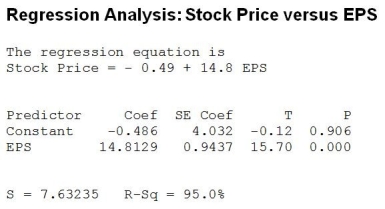
Which of the following statement is true about the correlation between stock price and EPS?
A) The correlation is negative.
B) The correlation is not significantly different from zero.
C) The correlation is positive and significantly different from zero.
D) The correlation is negative and significantly different from zero.
E) Cannot be determined from the information given.
Stock prices and earnings per share (EPS) data were collected for a sample of 15 companies. Below are the regression results. The dependent variable is Stock Price.

Which of the following statement is true about the correlation between stock price and EPS?
A) The correlation is negative.
B) The correlation is not significantly different from zero.
C) The correlation is positive and significantly different from zero.
D) The correlation is negative and significantly different from zero.
E) Cannot be determined from the information given.

Unlock Deck
Unlock for access to all 40 flashcards in this deck.
Unlock Deck
k this deck
25
Which of the following is the correct interpretation for the regression coefficient of Green?
A) The regression coefficient indicates that the PE ratio of a firm that is green will, on average, be 2.09 points higher than a firm that is not green with the same profit growth rate and profit margin.
B) The regression coefficient indicates that the PE ratio of a firm that is green will, on average, be 2.09 points lower than a firm that is not green with the same profit growth rate and profit margin.
C) The regression coefficient indicates that the PE ratio of a firm that is green will, on average, be 2.09 points times higher than a firm that is not green.
D) The regression coefficient indicates that the PE ratio of a firm that is green will, on average, be 2.09 points times lower than a firm that is not green.
E) The regression coefficient is not significantly different from zero.
A) The regression coefficient indicates that the PE ratio of a firm that is green will, on average, be 2.09 points higher than a firm that is not green with the same profit growth rate and profit margin.
B) The regression coefficient indicates that the PE ratio of a firm that is green will, on average, be 2.09 points lower than a firm that is not green with the same profit growth rate and profit margin.
C) The regression coefficient indicates that the PE ratio of a firm that is green will, on average, be 2.09 points times higher than a firm that is not green.
D) The regression coefficient indicates that the PE ratio of a firm that is green will, on average, be 2.09 points times lower than a firm that is not green.
E) The regression coefficient is not significantly different from zero.

Unlock Deck
Unlock for access to all 40 flashcards in this deck.
Unlock Deck
k this deck
26
Use the following to answer the question(s) below.
Data were collected for a sample of 12 pharmacists to determine if years of experience and salary are related. Below are the regression analysis results. The dependent variable is Salary in thousands of dollars.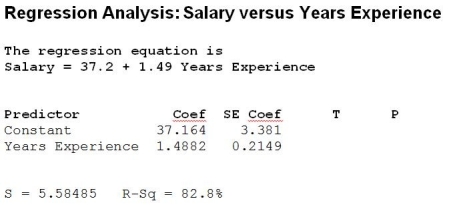
The standard error of the slope for this estimated regression equation is
A) 3.381
B) 0.2149
C) 5.58485
D) 82.8
E) 1.4882
Data were collected for a sample of 12 pharmacists to determine if years of experience and salary are related. Below are the regression analysis results. The dependent variable is Salary in thousands of dollars.

The standard error of the slope for this estimated regression equation is
A) 3.381
B) 0.2149
C) 5.58485
D) 82.8
E) 1.4882

Unlock Deck
Unlock for access to all 40 flashcards in this deck.
Unlock Deck
k this deck
27
Use the following to answer the question(s) below.
A newly developed drug is tested to determine absorption levels in a patient's bloodstream. A patient is injected with the drug and the concentration (units/cc) in the patient's blood is measured every hour for seven hours. Below is the output from fitting a linear regression model.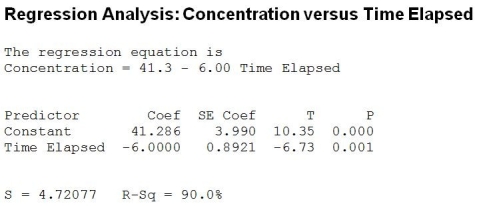
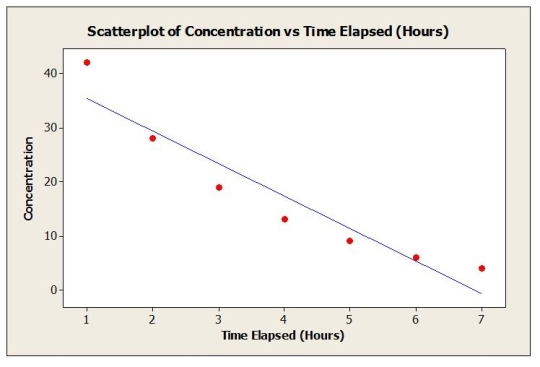
Which of the following is true?
A) The linear model is appropriate for estimation of the concentration level after 10 hours given that it explains 90% of the variability in blood concentration levels of the drug.
B) This model will underestimate the concentration level after 10 hours has elapsed because the linear model is not appropriate.
C) This model will overestimate the concentration level after 10 hours has elapsed because the linear model is not appropriate.
D) The linear model is appropriate for estimation of the concentration level after 10 hours given that it explains 9.49% of the variability in blood concentration levels of the drug.
E) The linear model is appropriate given that it explains 90% of the variability in blood concentration levels of the drug, and it will overestimate the concentration level after 10 hours.
A newly developed drug is tested to determine absorption levels in a patient's bloodstream. A patient is injected with the drug and the concentration (units/cc) in the patient's blood is measured every hour for seven hours. Below is the output from fitting a linear regression model.


Which of the following is true?
A) The linear model is appropriate for estimation of the concentration level after 10 hours given that it explains 90% of the variability in blood concentration levels of the drug.
B) This model will underestimate the concentration level after 10 hours has elapsed because the linear model is not appropriate.
C) This model will overestimate the concentration level after 10 hours has elapsed because the linear model is not appropriate.
D) The linear model is appropriate for estimation of the concentration level after 10 hours given that it explains 9.49% of the variability in blood concentration levels of the drug.
E) The linear model is appropriate given that it explains 90% of the variability in blood concentration levels of the drug, and it will overestimate the concentration level after 10 hours.

Unlock Deck
Unlock for access to all 40 flashcards in this deck.
Unlock Deck
k this deck
28
Which of the following is/are true about the best regression models?
A) They have relatively few predictors.
B) They have a relatively high R2 value.
C) They have predictors that are reliably measured and relatively unrelated to each other.
D) They have no cases with extraordinarily high leverage that might dominate and alter the model.
E) All of the given statements are true.
A) They have relatively few predictors.
B) They have a relatively high R2 value.
C) They have predictors that are reliably measured and relatively unrelated to each other.
D) They have no cases with extraordinarily high leverage that might dominate and alter the model.
E) All of the given statements are true.

Unlock Deck
Unlock for access to all 40 flashcards in this deck.
Unlock Deck
k this deck
29
Use the following to answer the questions below.
The following is output from regression analysis performed to develop a model for predicting a firm's Price-Earnings Ratio (PE) based on Growth Rate, Profit Margin, and whether or not the firm is Green (1 = Yes, 0 = No).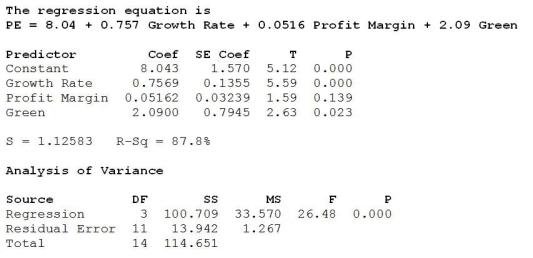
At α = 0.05 we can conclude that
A) Growth Rate is not a significant variable in predicting a firm's PE ratio.
B) Profit Margin is a significant variable in predicting a firm's PE ratio.
C) The regression coefficient associated with Growth Rate is not significantly different from zero.
D) Whether or not a firm is Green is significant in predicting its PE ratio.
E) The regression coefficient associated with whether or not a firm is Green is not significantly different from zero.
The following is output from regression analysis performed to develop a model for predicting a firm's Price-Earnings Ratio (PE) based on Growth Rate, Profit Margin, and whether or not the firm is Green (1 = Yes, 0 = No).

At α = 0.05 we can conclude that
A) Growth Rate is not a significant variable in predicting a firm's PE ratio.
B) Profit Margin is a significant variable in predicting a firm's PE ratio.
C) The regression coefficient associated with Growth Rate is not significantly different from zero.
D) Whether or not a firm is Green is significant in predicting its PE ratio.
E) The regression coefficient associated with whether or not a firm is Green is not significantly different from zero.

Unlock Deck
Unlock for access to all 40 flashcards in this deck.
Unlock Deck
k this deck
30
The P-value associated with this statistic is < 0.001. At the 0.05 level of significance
A) We reject the null hypothesis.
B) We do not reject the null hypothesis.
C) We conclude that years of experience is significant in explaining pharmacists' salary.
D) We reject the null hypothesis, and we conclude that years of experience is significant in explaining pharmacists' salary.
E) We do not reject the null hypothesis, and we conclude that years of experience is significant in explaining pharmacists' salary.
A) We reject the null hypothesis.
B) We do not reject the null hypothesis.
C) We conclude that years of experience is significant in explaining pharmacists' salary.
D) We reject the null hypothesis, and we conclude that years of experience is significant in explaining pharmacists' salary.
E) We do not reject the null hypothesis, and we conclude that years of experience is significant in explaining pharmacists' salary.

Unlock Deck
Unlock for access to all 40 flashcards in this deck.
Unlock Deck
k this deck
31
Using the estimated regression equation to predict salary for 10 years of experience gives the following results.  Which of the following is true?
Which of the following is true?
A) 95% of pharmacists with 10 years of experience earn between $38,960 and $65,130.
B) 95% of pharmacists with 10 years of experience earn between $48,010 and $56,080.
C) We are 95% confident that a particular pharmacist who has 10 years of experience earns between $38,960 and $65,130.
D) We are 95% confident that a particular pharmacist who has 10 years of experience earns between $48,010 and $56,080.
E) 95% of pharmacists with 10 years experience on average earn between $48,010 and $56,080.
 Which of the following is true?
Which of the following is true?A) 95% of pharmacists with 10 years of experience earn between $38,960 and $65,130.
B) 95% of pharmacists with 10 years of experience earn between $48,010 and $56,080.
C) We are 95% confident that a particular pharmacist who has 10 years of experience earns between $38,960 and $65,130.
D) We are 95% confident that a particular pharmacist who has 10 years of experience earns between $48,010 and $56,080.
E) 95% of pharmacists with 10 years experience on average earn between $48,010 and $56,080.

Unlock Deck
Unlock for access to all 40 flashcards in this deck.
Unlock Deck
k this deck
32
How much of the variability in pharmacists' salary is accounted for by years of experience?
A) 82.8 %
B) 47.97 %
C) 5.58485 thousand dollars
D) 10.99 %
E) 98.9 %
A) 82.8 %
B) 47.97 %
C) 5.58485 thousand dollars
D) 10.99 %
E) 98.9 %

Unlock Deck
Unlock for access to all 40 flashcards in this deck.
Unlock Deck
k this deck
33
Below are residual plots for this regression model. 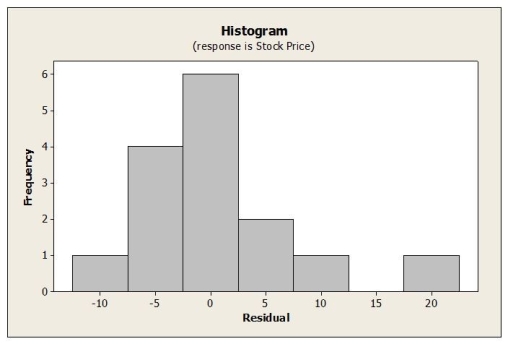

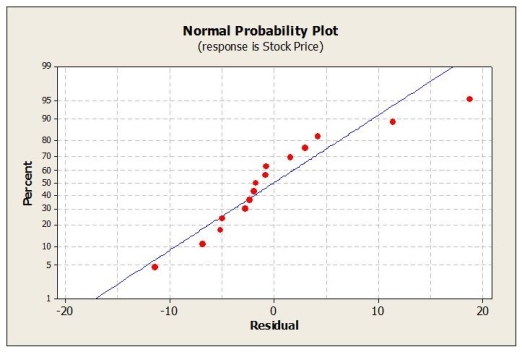 Based on these plots, which assumption appears to be violated?
Based on these plots, which assumption appears to be violated?
A) Equal Variance
B) Linearity
C) Normality
D) Independence
E) None; all appear to be satisfied.


 Based on these plots, which assumption appears to be violated?
Based on these plots, which assumption appears to be violated?A) Equal Variance
B) Linearity
C) Normality
D) Independence
E) None; all appear to be satisfied.

Unlock Deck
Unlock for access to all 40 flashcards in this deck.
Unlock Deck
k this deck
34
A least squares estimated regression line has been fitted to a set of data and the resulting residual plot is shown. Which is true? 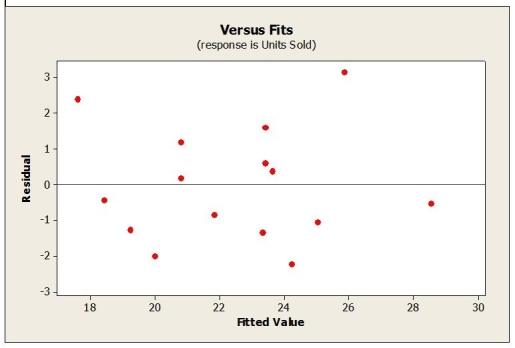
A) The linear model is appropriate.
B) The linear model is poor because some residuals are large.
C) The linear model is poor because the correlation is near 0.
D) A curved model would be better.
E) A transformation of the data is required.

A) The linear model is appropriate.
B) The linear model is poor because some residuals are large.
C) The linear model is poor because the correlation is near 0.
D) A curved model would be better.
E) A transformation of the data is required.

Unlock Deck
Unlock for access to all 40 flashcards in this deck.
Unlock Deck
k this deck
35
Use the following to answer the question(s) below.
Data were collected for a sample of 12 pharmacists to determine if years of experience and salary are related. Below are the regression analysis results. The dependent variable is Salary in thousands of dollars.
The calculated t-statistic to test whether the regression slope is significant is
A) 10.99
B) 47.97
C) 31.2
D) 6.93
E) 5.58485
Data were collected for a sample of 12 pharmacists to determine if years of experience and salary are related. Below are the regression analysis results. The dependent variable is Salary in thousands of dollars.

The calculated t-statistic to test whether the regression slope is significant is
A) 10.99
B) 47.97
C) 31.2
D) 6.93
E) 5.58485

Unlock Deck
Unlock for access to all 40 flashcards in this deck.
Unlock Deck
k this deck
36
Which of the following measures is used to check for collinearity when building a multiple regression model?
A) Cook's Distance
B) Variance Inflation Factor
C) Determination Coefficient
D) Standardized Residual
E) Chef's Distance
A) Cook's Distance
B) Variance Inflation Factor
C) Determination Coefficient
D) Standardized Residual
E) Chef's Distance

Unlock Deck
Unlock for access to all 40 flashcards in this deck.
Unlock Deck
k this deck
37
Use the following to answer the question(s) below.
A newly developed drug is tested to determine absorption levels in a patient's bloodstream. A patient is injected with the drug and the concentration (units/cc) in the patient's blood is measured every hour for seven hours. Below is the output from fitting a linear regression model.

Re-expressing these data results in the following model The residuals plotted against the fitted values for this model is shown below.
The residuals plotted against the fitted values for this model is shown below. 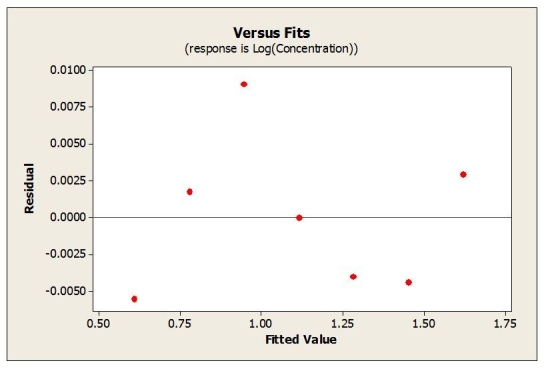 What is true about the predicted concentration level after 10 hours has elapsed?
What is true about the predicted concentration level after 10 hours has elapsed?
A) The predicted value is 0.1000 units/cc.
B) This value is considered as a regular one.
C) This value is accurate because R2 = 100%.
D) The predicted value is 1.2589 units/cc, and this value is considered an extrapolation.
E) All of the given statements are true.
A newly developed drug is tested to determine absorption levels in a patient's bloodstream. A patient is injected with the drug and the concentration (units/cc) in the patient's blood is measured every hour for seven hours. Below is the output from fitting a linear regression model.


Re-expressing these data results in the following model
 The residuals plotted against the fitted values for this model is shown below.
The residuals plotted against the fitted values for this model is shown below.  What is true about the predicted concentration level after 10 hours has elapsed?
What is true about the predicted concentration level after 10 hours has elapsed?A) The predicted value is 0.1000 units/cc.
B) This value is considered as a regular one.
C) This value is accurate because R2 = 100%.
D) The predicted value is 1.2589 units/cc, and this value is considered an extrapolation.
E) All of the given statements are true.

Unlock Deck
Unlock for access to all 40 flashcards in this deck.
Unlock Deck
k this deck
38
Use the following to answer the questions below.
The following is output from regression analysis performed to develop a model for predicting a firm's Price-Earnings Ratio (PE) based on Growth Rate, Profit Margin, and whether or not the firm is Green (1 = Yes, 0 = No).
Based on the F-statistic and associated P-value, we can conclude at α = 0.05 that
A) The regression equation is not significant.
B) All independent variables in the model are significant.
C) The regression model is significant overall.
D) None of the independent variables in the model are significant.
E) All independent variables in the model are significant, but the regression model is not significant overall.
The following is output from regression analysis performed to develop a model for predicting a firm's Price-Earnings Ratio (PE) based on Growth Rate, Profit Margin, and whether or not the firm is Green (1 = Yes, 0 = No).

Based on the F-statistic and associated P-value, we can conclude at α = 0.05 that
A) The regression equation is not significant.
B) All independent variables in the model are significant.
C) The regression model is significant overall.
D) None of the independent variables in the model are significant.
E) All independent variables in the model are significant, but the regression model is not significant overall.

Unlock Deck
Unlock for access to all 40 flashcards in this deck.
Unlock Deck
k this deck
39
Use the following to answer the question(s) below.
A linear regression model was fit to data representing technology adoption over time. The regression output and residual plot appears below.

It is known that at 1% significance level the critical values for Durbin-Watson statistic are 0.738 and 1.038. The Durbin-Watson statistic indicates
A) that the residuals are positively autocorrelated
B) that the residuals are negatively autocorrelated
C) that the residuals are not autocorrelated
D) that the test is inconclusive
E) The Durbin-Watson cannot be used for this model.
A linear regression model was fit to data representing technology adoption over time. The regression output and residual plot appears below.


It is known that at 1% significance level the critical values for Durbin-Watson statistic are 0.738 and 1.038. The Durbin-Watson statistic indicates
A) that the residuals are positively autocorrelated
B) that the residuals are negatively autocorrelated
C) that the residuals are not autocorrelated
D) that the test is inconclusive
E) The Durbin-Watson cannot be used for this model.

Unlock Deck
Unlock for access to all 40 flashcards in this deck.
Unlock Deck
k this deck
40
Use the following to answer the question(s) below.
Stock prices and earnings per share (EPS) data were collected for a sample of 15 companies. Below are the regression results. The dependent variable is Stock Price.
What is the correlation between stock price and EPS?
A) -0.975
B) 0.975
C) 0.906
D) 0.950
E) Cannot be determined from the information given.
Stock prices and earnings per share (EPS) data were collected for a sample of 15 companies. Below are the regression results. The dependent variable is Stock Price.

What is the correlation between stock price and EPS?
A) -0.975
B) 0.975
C) 0.906
D) 0.950
E) Cannot be determined from the information given.

Unlock Deck
Unlock for access to all 40 flashcards in this deck.
Unlock Deck
k this deck



